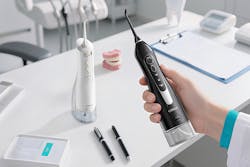Oral hygiene challenges during braces and how to overcome them safely
Key Highlights
- Plaque tends to accumulate around brackets and wires, increasing the risk of gum inflammation and enamel demineralization.
- Water flossers provide pulsating streams of water that reach difficult areas, improving plaque removal and reducing gum bleeding.
- Using interdental brushes and rinsing after meals can help dislodge food debris and prevent plaque buildup.
- Regular dental check-ups and professional cleanings are essential to monitor oral health during orthodontic treatment.
- COSLUS offers clinically inspired water flossers designed to make effective cleaning easier and motivate patients to maintain oral hygiene.
Braces are a valuable investment in long-term oral health and aesthetics, but they also introduce unique hygiene challenges. Fixed orthodontic appliances create new niches where plaque can thrive, potentially leading to gum inflammation, enamel demineralization, and halitosis if not addressed properly. To help patients navigate these challenges, COSLUS, working with dental professionals, shares practical tips for maintaining a healthy smile during orthodontic treatment.
Why Oral Hygiene Gets Harder with Braces
Clinical studies have shown that orthodontic brackets and wires significantly increase plaque retention. Even with diligent brushing, certain areas, such as around the brackets, along the gumline, and between teeth, can remain inadequately cleaned. Over time, this can lead to:
l Gingivitis (early gum disease)
l White spot lesions (early enamel decay)
l Persistent bad breath
Modern Solutions for a Classic Problem
Dentists today often recommend adjunctive cleaning tools, devices used in addition to manual or electric toothbrushes to improve plaque removal. One option gaining popularity is the oral irrigator, also known as a water flosser.
Water flossers work by delivering pulsating streams of water that flush out food debris and disrupt bacterial biofilm in areas where floss and brushes may struggle to reach. For orthodontic patients, this means:
l Better access around brackets and wires
l Reduced gum bleeding and inflammation
l Increased daily cleaning compliance
Examples from Clinical Practice
In many orthodontic clinics, patients with low flossing compliance have been introduced to adjustable pressure water flossers for more comfortable daily use. Devices like the COSLUS E40 (with stepless 10-stage pressure control for sensitive gums) and the COSLUS C20 (with dual-thread pulses for deeper irrigation) have been used as part of home care protocols to support gum health during treatment.
Both models are engineered to meet American Dental Association (ADA) standards and are currently in the certification process. While tools differ, the goal is the same: make effective cleaning easier, so patients stay motivated.
Practical Tips for Braces-Friendly Oral Care
Brush twice daily with fluoride toothpaste, focusing on each bracket
Use interdental brushes or water flossers to clean between teeth and around wires
Rinse after meals to remove loose debris
Visit your orthodontist for regular check-ups and professional cleanings
About COSLUS
COSLUS focuses on clinically inspired home oral care devices, combining dental expertise with user-friendly design. Every COSLUS water flosser comes with a 2-Year Warranty, 30-Day No Hassle Returns, and 1 business hour weekday support.
Official Website: http://www.coslus.com
Customer Support: [email protected] | +1 855 594 3950
Company Address: 17800 Castleton St., Ste 665, City of Industry, CA 91748, USA


